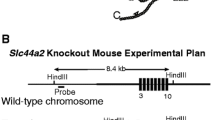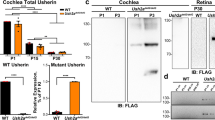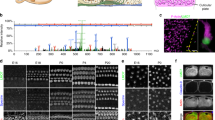Abstract
We have undertaken a phenotypic approach in the mouse to identifying molecules involved in inner ear function by N-ethyl-N-nitrosourea mutagenesis followed by screening for new dominant mutations affecting hearing or balance. The pathology and genetic mapping of the first of these new mutants, tailchaser (Tlc), is described here. Tlc/+ mutants display classic behavioural symptoms of a vestibular dysfunction, including head-shaking and circling. Behavioural testing of ageing mice revealed a gradual deterioration of both hearing and balance function, indicating that the pathology caused by the Tlc mutation is progressive, similar to many dominant nonsyndromic deafnesses in humans. Based on scanning electron microscopy (SEM) studies, Tlc clearly plays a developmental role in the hair cells of the cochlea since the stereocilia bundles fail to form the characteristic V-shape pattern around the time of birth. By young adult stages, Tlc/+ outer hair bundles are grossly disorganised although inner hair bundles appear relatively normal by SEM. Increased compound action potential thresholds revealed that the Tlc/+ cochlear hair cells were not functioning normally in young adults. Similar to inner hair cells, the hair bundles of the vestibular hair cells also do not appear grossly disordered. However, all types of hair cells in the Tlc/+ inner ear eventually degenerate, apparently regardless of the degree of organisation of their hair bundles. We have mapped the Tlc mutation to a 12 cM region of chromosome 2, between D2Mit164 and D2Mit423. Based on the mode of inheritance and map location, Tlc appears to be a novel mouse mutation affecting both hair cell survival and stereocilia bundle development.
Similar content being viewed by others
References
AVRAHAM, K. B., HASSON, T., STEEL, K. P.,KINGSLEY, D. M., RUSSELL, L. B., MOOSEKER,M. S., COPELAND, N. G.& JENKINS, N. A.(1995)The mouse Snellos waltzer deafness gene encodes an unconventionalmyosin required for structural integrity ofinner ear hair cells. Nat. Genet. 11, 369–375.
BARK, I. C., HAHN, K. M., RYABININ, A. E.& WILSON,M. C.(1995) Differential expression of SNAP-25 proteinisoforms during divergent vesicle fusion events of neuraldevelopment. Proc. Natl. Acad. Sci. USA 92, 1510–1514.
BERGSTROM, R. A., YOU, Y., ERWAY, L. C., LYON,M. F.& SCHIMENTI, J. C.(1998) Deletion mappingof the head tilt (het) gene in mice: A vestibular mutationcausing specific absence of otoliths. Genetics 150, 815-822.
Brown, S. D. M.& Nolan, P. M.(1998) Mouse mutagenesis-systematic studies of mammalian gene function. Hum.Mol.Genet. 7, 1627–1633.
CAMPBELL, D. A., MCHALE, D. P., BROWN, K. A.,MOYNIHAN, L. M., HOUSEMAN, M., KARBANI,G., PARRY, G., JANJUA, A. H., NEWTON, V.,AL-GAZALI, L., MARKHAM, A. F., LENCH, N. J. & MUELLER, R. F.(1997) A new locus for nonsyndromal,autosomal recessive, sensorineural hearingloss (DFNB16) maps to human chromosome 15q21-q22.J. Med. Genet. 34, 1015–1017.
Douglas, R. J., Clark, G. M., Erway, L. C., HUBBARD, D. G. & Wright, C. G.(1979) Effects of genetic vestibular defects on behavior related to spatial orientation and emotionality. J.Comp.Physiol.Psychol. 93, 467–480.
Flaherty, L.(1998) Generation, identification, and recovery of mouse mutations. Methods 14, 107–118.
Flint, J., Corley, R., Defries, J. C., Fulker, D. W., GRAY, J. A.,Miller, S.& Collins, A. C.(1995) A simple genetic basis for a complex psychological trait in laboratory mice. Science 269, 1432–1435.
FUKUSHIMA, K., KASAI, N., UEKI, Y., NISHIZAKI,K., SUGATA, K., HIRAKAWA, S., MASUDA, A.,GUNDUZ, M., NINOMIYA, Y., MASUDA, Y., SATO,M., MCGUIRT, W. T., COUCKE, P., VAN CAMP, G. & SMITH, R. J.(1999) A gene for fluctuating, progressiveautosomal dominant nonsyndromic hearing loss,DFNA16, maps to chromosome 2q23–24.3. Am. J. Hum.Genet. 65, 141–150.
Gibson, F., Walsh, J., Mburu, P., Varela, A., BROWN, K. A.,Antonio, M., Beisel, K. W., STEEL, K. P.& Brown, S. D.(1995) Atype VII myosin encoded by the mouse deafness gene shaker-1. Nature 374, 62–64.
Gorlin, R. J., Toriello, H. V.& Cohen, M. M.1995. Hereditary Hearing Loss and its Syndromes. Oxford: Oxford University Press
Harvey, D.& Steel, K. P.(1992) The development and interpretation of the summating potential response. Hear. Res. 61, 137–146.
Hess, E. J., Collins, K. A., Copeland, N. G., JENKINS, N. A. & Wilson, M. C.(1994) Deletion map of the coloboma (Cm) locus on mouse chromosome 2. Genomics 21, 257–261.
Hess, E. J., Collins, K. A.& Wilson, M. C.(1996) Mouse model of hyperkinesis implicates SNAP-25 in behavioral regulation. J.Neurosci. 16, 3104–3111.
HESS, E. J., JINNAH, H. A., KOZAK, C. A.& WILSON,M. C.(1992) Spontaneous locomotor hyperactivity in amouse mutant with a deletion including the Snap geneon chromosome 2. J. Neurosci. 12, 2865–2874.
Hrabe de angelis, M.& Balling, R.(1998) Large scale ENU screens in the mouse: genetics meets genomics. Mutat.Res. 400, 25–32.
Hunter-duvar, I. M.(1978) Atechnique for preparation of cochlear specimens for assessment with the scanning electron microscope. Acta.Otolaryngol.Suppl.(Stockh.) 351, 3–23.
Ikeda, A., Zheng, Q. Y., Rosenstiel, P., MADDATU, T.,Zuberi, A. R., Roopenian, D. C., NORTH, M. A.,Naggert, J. K., Johnson, K. R.& NISHINA, P. M.(1999) Genetic modification of hearing in tubby mice: Evidence for the existence of a major gene (moth1) which protects tubby mice from hearing loss. Hum.Mol.Genet. 8, 1761–1767.
JAIN, P. K., LALWANI, A. K., LI, X. C., SINGLETON,T. L., SMITH, T. N., CHEN, A., DESHMUKH, D.,VERMA, I. C., SMITH, R. J.& WILCOX, E. R.(1998)Agene for recessive nonsyndromic sensorineural deafness(DFNB18) maps to the chromosomal region 11p14-p15.1containing the Usher syndrome type 1C gene. Genomics 50, 290–292.
KALTENBACH, J. A., FALZARANO, P. R.& SIMPSON,T. H.(1994) Postnatal development of the hamstercochlea. II. Growth and differentiation of stereocilia bundles.J. Comp. Neurol. 350, 187–198.
Kikuchi, K.& Hilding, D. A.(1965) The development of the organ of Corti in the mouse. Acta Otolaryngol.(Stockh.) 60, 207–222.
Kimura, R. S.(1966) Hairs of the cochlear sensory cells and their attachment to the tectorial membrane. Acta Otolaryngol. (Stockh.) 61, 55–72.
Kitamura K. KakoiH. YoshikawaY.& OCHIKUBO, F. (1992) Ultrastructural findings in the inner ear of Jackson shaker mice. Acta Otolaryngol.(Stockh.) 112, 622–627
KITAMURA, K., NOMURA, Y., YAGI, M., YOSHIKAWA,Y.& OCHIKUBO, F.(1991) Morphological changes ofcochlea in a strain of new-mutant mice. Acta Otolaryngol.(Stockh.) 111, 61–69.
Kollmar, R.(1999) Who does the hair cellÕs Õdo? Rho GTPases and hair-bundle morphogenesis. Curr.Opin. Neurobiol. 9, 394–398.
LEWIS, A. K., FRANTZ, G. D., CARPENTER, D. A., DESAUVAGE, F. J.& GAO, W. Q.(1998) Distinct expressionpatterns of notch family receptors and ligands duringdevelopment of the mammalian inner ear. Mech. Dev. 78, 159–163.
Lim, D. J.& Anniko, M.(1985) Developmental morphology of the mouse inner ear. A scanning electron microscopic observation. Acta Otolaryngol.Suppl.(Stockh.) 422, 1–69.
Lyon, M. F.(1951) Hereditary absence of otoliths in the house mouse. Journal of Physiology 114, 410–418.
Lyon, M. F.(1952) Absence of otoliths in the mouse: An effect of the pallid mutant. Journal of Genetics 51, 213–229.
Malicki, J., Schier, A. F., Solnica-krezel, L., Stemple, D. L., Neuhauss, S. C., STAINIER, D. Y., Abdelilah, S., Rangini, Z., Zwartkruis, F.& Driever, W.(1996) Mutations affecting development of the zebrafish ear. Development 123, 275–283.
Marshall, J. F.& Berrios, N.(1979) Movement disorders of aged rats: Reversal by dopamine receptor stimulation. Science 206, 477–479.
Moriyama, K., Hashimoto, R., Hanai, A., YOSHIZAKI, N., Yonezawa, S.& Otani, H.(1997) Degenerative hairlets on the vestibular sensory cells in mutant bustling (BUS/Idr) mice. Acta Otolaryngol.(Stockh.) 117, 20–24
Morton, N. E.(1991) Genetic epidemiology of hearing impairment. Annals of the New York Academy of Sciences 630, 16–31.
NICOLSON, T., USCH, A., FRIEDRICH, R. W.,GRANATO, M., RUPPERSBERG, J. P.& NUSSLEINVOLHARD,C.(1998) Genetic analysis of vertebrate sensoryhair cell mechanosensation: The zebrafish circlermutants. Neuron 20, 271–283.
Online mendelian inheritance in man, omim (tm) (1999) Center for Medical Genetics, Johns Hopkins University (Baltimore, MD) and National Center for Biotechnology Information, National Library of Medicine, Bethesda, MD. World Wide Web URL: http://www.ncbi.nlm.nih.gov/omim/.
Ornitz, D. M., Bohne, B. A., Thalmann, I., HARDING, G. W. & Thalmann, R.(1998) Otoconial agenesis in tilted mutant mice. Hear.Res. 122, 60–70.
OSSENKOPP, K. P., PRKACIN, A.& HARGREAVES,E. L.(1990) Sodium arsanilate-induced vestibular dysfunctionin rats: Effects on open-field behavior and spontaneousactivity in the automated digiscan monitoringsystem. Pharmacol. Biochem. Behav. 36, 875–881.
Porter, J. D., Pellis, S. M.& Meyer, M. E.(1990) An open-field activity analysis of labyrinthectomized rats. Physiol.Behav. 48, 27–30.
Probst, F. J.& Camper, S. A.(1999) The role of mouse mutants in the identification of human hereditary hearing loss genes. Hear.Res. 130, 1–6.
PROBST, F. J., FRIDELL, R. A., RAPHAEL, Y.,SAUNDERS, T. L., WANG, A., LIANG, Y., MORELL,R. J., TOUCHMAN, J. W., LYONS, R. H., NOBENTRAUTH,K., FRIEDMAN, T. B.& CAMPER, S. A.(1998) Correction of deafness in shaker-2 mice by an unconventionalmyosin in a BAC transgene. Science 280,1444–1447.
RHODES, M., STRAW, R., FERNANDO, S., EVANS,A., LACEY, T., DEARLOVE, A., GREYSTRONG,J., WALKER, J., WATSON, P., WESTON, P.,KELLY, M., TAYLOR, D., GIBSON, K., MUNDY,C., BOURGADE, F., POIRIER, C., SIMON, D.,BRUNIALTI, A. L., MONTAGUTELLI, X., GUOENET,J. L., HAYNES, A.& BROWN, S. D.(1998) A highresolutionmicrosatellite map of the mouse genome.Genome. Res. 8, 531–542.
ROGERS, M. J., FLEMING, J., KIERNAN, B. W., MBURU,P., VARELA, A., BROWN, S. D.& STEEL, K. P.(1999)Genetic mapping of the whirler mutation. MammGenome 10, 513–519.
Russell, W. L., Kelly, E. M., Hunsicker, P. R., BANGHAM, J. W.,Maddux, S. C.& Phipps, E. L.(1979) Specific-locus test shows ethylnitrosourea to be the most potent mutagen in the mouse. Proc.Natl.Acad. Sci.USA 76, 5818–5819
Self, T., Mahony, M., Fleming, J., Walsh, J., BROWN, S. D. & Steel, K. P.(1998) Shaker-1 mutations reveal roles for myosin VIIA in both development and function of cochlear hair cells. Development 125, 557–566.
Self, T., Sobe, T., Copeland, N. G., Jenkins, N. A., AVRAHAM, K. B. & Steel, K. P.(1999) Role of myosin VI in the differentiation of cochlear hair cells. Developmental Biology 214, 331–341.
Shnerson, A.& Pujol, R.(1981) Age-related changes in the C57BL/6J mouse cochlea. I. Physiological findings. Brain.Res. 254, 65–75.
TLC: A NEW MOUSE MUTANT WITH HAIR BUNDLE DEFECTS 985 SOBKOWICZ, H. M., Slapnick, S. M.& August, B. K.(1995) The kinocilium of auditory hair cells and evidence for its morphogenetic role during the regeneration of stereocilia and cuticular plates. J.Neurocytol. 24, 633–653
Steel, K. P.& Hardisty, R.(1996) Assessing hearing, vision and balance in mice. Society for Neuroscience Short Course.
Tilney, L. G., Tilney, M. S.& Derosier, D. J.(1992a) Actin filaments, stereocilia, and hair cells: How cells count and measure. Annu.Rev.Cell.Biol. 8, 257–274
Tilney, L. G., Cotanche, D. A.& Tilney, M. S.(1992b) Actin filaments, stereocilia and hair cells of the bird cochlea. VI. How the number and arrangement of stereocilia are determined. Development 116, 213–226
Van camp, G.& Smith, R.(1999) Hereditary hearing loss homepage. World Wide Web URL: http://dnalab-www. uia.ac.be/dnalab/hhh/.
Wenngren, B. I.& Anniko, M.(1988) Age-related auditory brainstem response (ABR) threshold changes in the dancer mouse mutant. Acta Otolaryngol.(Stockh.) 106, 386–392.
Wenngren, B. I.& Anniko, M.(1990) Aberrant frequency tuning and early stereociliary derangement in genetic inner ear disease. Acta Otolaryngol.(Stockh.) 109, 202–212.
WHITEHEAD INSTITUTE FOR BIOMEDICAL RESEARCH/MIT CENTER FOR GENOME RESEARCH. (1999) http://www-genome.wi.mit.edu/cgi-bin/ mouse/index.
WHITFIELD, T. T., GRANATO, M., VAN EEDEN,F. J., SCHACH, U., BRAND, M., FURUTANISEIKI,M., HAFFTER, P., HAMMERSCHMIDT, M.,HEISENBERG, C. P., JIANG, Y. J., KANE, D. A.,KELSH, R. N., MULLINS, M. C., ODENTHAL, J.&NUSSLEIN-VOLHARD, C.(1996) Mutations affectingdevelopment of the zebrafish inner ear and lateral line.Development 123, 241–254.
Xue, Y., Gao, X., Lindsell, C. E., Norton, C. R., Chang, B., Hicks, C., Gendron-maguire, M., Rand, E. B., Weinmaster, G.& Gridley, T.(1999) Embryonic lethality and vascular defects in mice lacking the Notch ligand Jagged1. Hum.Mol.Genet. 8, 723–730
Yasunaga, S., Grati, M., Cohen-salmon, M., El-amraoui, A., Mustapha, M., Salem, N., El-zir, E., Loiselet, J.& Petit, C.(1999) A mutation in OTOF, encoding otoferlin, a FER-1-like protein, causes DFNB9, a nonsyndromic form of deafness. Nat. Genet. 21, 363–369
YONEZAWA, S., NODASAKA, Y., KAMADA,T., FUJITA, S. C., KATO, K., YAMADA, Y.,OGASAWARA, N.& SHOJI, R.(1996) Cochlearhistopathology of the mutant bustling mouse, BUS/Idr.Acta Otolaryngol. (Stockh.) 116, 409–416.
Author information
Authors and Affiliations
Rights and permissions
About this article
Cite this article
Kiernan, A.E., Zalzman, M., Fuchs, H. et al. Tailchaser (Tlc): A new mouse mutation affecting hair bundle differentiation and hair cell survival. J Neurocytol 28, 969–985 (1999). https://doi.org/10.1023/A:1007090626294
Issue Date:
DOI: https://doi.org/10.1023/A:1007090626294




